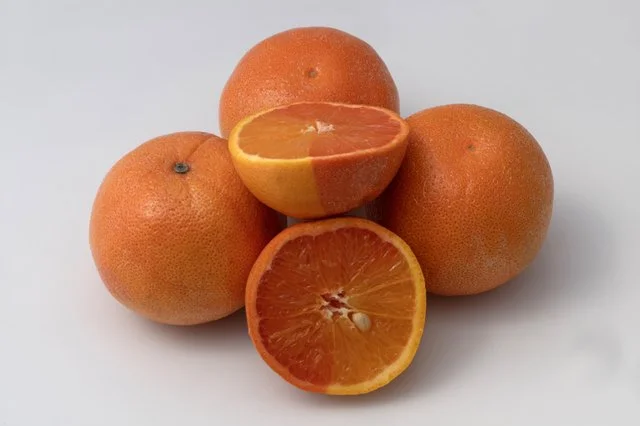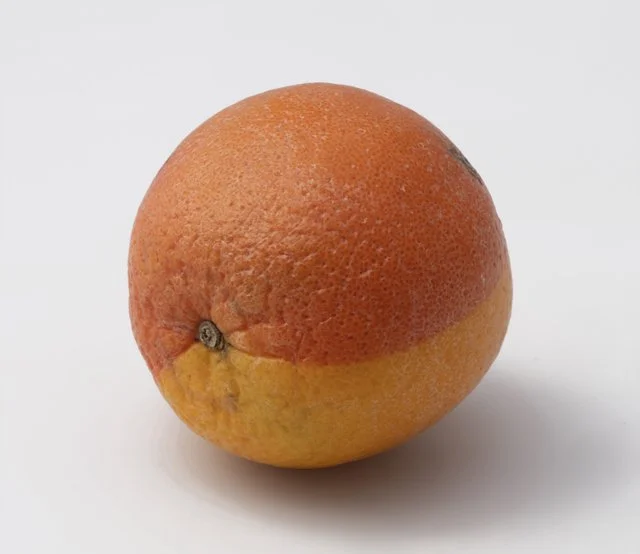
FAQs and Fun Facts
Frequently Asked Questions
-
Based on the most recent commercial planting, the yield is consistent with the cropping of a young Olinda Valencia grove. There has been no alternate bearing pattern.
The size of the fruit ranges in order of most to least: 88s, 113s, 138s, and 72s. The Rosy Red has a round shape with a smooth rind.
We reported a successful 2023 summer harvest of Rosy Red Valencia. Just four years after the original planting of 10 acres in June 2019 and April 2020, we finished our first commercial harvest of 33 tons of fruit. The same block in 2024 yielded 110 tons of harvested fruit.In the last few years as the trees grow and new blocks come into production, we’ve seen a significantly higher volume of packed fruit.
-
Test plots established in 2014 with 400 trees have shown no vulnerabilities at this time. Commercial planting established in 2019 - 2020 demonstrates the trees grow well and set substantial fruit with both Carrizo and Rich 16 rootstock. Test trees and commercial planting have been monitored for trueness to type and the mutation is stable based on observation and testing since 2014.
-
Currently, there are more than 30,000 Rosy Red trees in the ground. These commercial plantings are located in several different places with distinct soils and microclimates. By the end of 2025 there will be more than 45,000 trees in the ground.
The trees grow vigorously and on two different commercially grown rootstocks—Carrizo and Rich 16. Rosy Red grows well in the citrus belt and does not require special horticultural growing conditions.
Pruning recommendations are typical for suckering and shaping of any young valencia tree. Fertilizer needs are typical of any young citrus planting. Rosy Red may be less attractive to certain citrus pests. -
Since the Rosy Red is a brand new variety that has never been commercially grown before, it has been a journey to understand the tree and the characteristics of the fruit. As a result, we have closely observed, monitored, and recorded the growing practices to see how the tree behaves as naturally as possible to understand the baseline information of the trees.
We have gathered data for more than 10 years—since the first experimental planting—about how the tree grows and how it sets the fruit. For example, much of the mature fruit is located on the inside of the tree, making the fruit less sensitive to sunburn. To understand if there is any natural resistance to any insects, conventional sprays for common insects were not applied to date.
Like any young tree, the Rosy Red needs fertilizer, either injected through the irrigation system or foliar or both. It is our general practice to fertilize using composted steer manure to build up the natural biome of the soil and improve nutrient uptake.
Trees are irrigated by fan jets or drippers to minimize loss of precious water outside the root zone of the tree. To date, the trees have been pruned minimally to preserve all of the new limbs to observe for any potential changes in the natural mutation of the Rosy Red.
-
Rosy Red is versatile, so there are many different ways in which it can be marketed.
The Rosy Red has lycopene and beta carotene—these are antioxidant components present in the Rosy Red. See fun fact below.
There is ongoing research investigating the health and medical benefits of the antioxidant components of pigmented citrus varieties. Several studies have been completed, including a recent study at the Department of Nutrition at UC Davis. Stay tuned for the results.
The Rosy Red is more drinkable because the sugar to acid ratio produces a full-bodies, well-balanced juice.
It can be displayed in market as an exciting new spring/summer citrus offering.
The beautiful color is ideal for specialty juice products and appeals to the high-end food service market—cocktails, ingredients in dishes, and peel for pretty garnish.
Since the Rosy Red is a protected patented variety that is only grown by TreeSource Nursery, our program will keep the volume in line with pricing and create a more profitable niche market for this versatile product.
Rosy Red was discovered in the California citrus belt and is confirmed for growing conditions of the Central Valley.
-
There are Rosy Red trees available on Rich 16 and Carrizo for planting in 2026 from TreeSource Nursery exclusively. They are available on a first-come, first-served basis. Orders for these trees are being processed by TreeSource Nursery right now.
The first step to becoming a grower is to arrange a meeting with Nancy to come out to the original 10-acre commercial planting and see these very special trees for yourself.
Fun Facts
University of California Davis (UC Davis) Study
Rosy Red Valencia was thrilled to participate in a study with the UC Davis Department of Nutrition. Completed in the summer of 2025, the study aims to evaluate the antioxidant and anti-inflammatory capacities of the Rosy Red Valencia and Olinda Valencia. The study involved monitoring healthy participants: Group 1 will consume 2 whole Rosy Red Valencia fruits per day and group 2 will consume 2 whole Olinda Valencia fruits per day. The results of the study will be available in the late fall. Stay tuned!
More Protection for the Rosy Red
The Rosy Red is double protected! We have a US Patent until the year 2036 and have just received a Plant Variety Protection (PVP) patent from the USDA until the year 2050.
Health Benefits
The Rosy Red contains lycopene, beta-carotene, and other antioxidants. Lycopene improves sun protection, heart health, and lowers incidents of certain types of cancer. Beta-carotene converts into vitamin A, which promotes health in the eyes, skin, and immune system.
These ingredients are known to be most beneficial when consumed from lycopene- and beta carotene-rich foods.
Chimeras
Occasionally chimeras will be seen on the mature fruit. This chimera is a natural occurrence of a genetic mutation (also seen on Cara Cara navel oranges). These chimera can give the fruit a little racing stripe where the pigment has reverted back to the original color. A chimera does not affect the taste of the fruit, but they are fun to see, so when we pack the Rosy Red, we leave the fruits with the racing stripes in the packed box.






